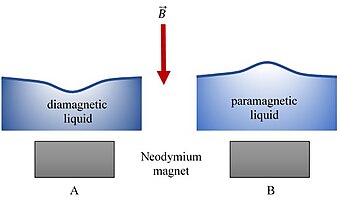In physics, the Moses effect is a phenomenon of deformation of the surface of a diamagnetic liquid by a magnetic field.[1][2] The effect was named after the biblical figure Moses, inspired by the mythological crossing of the Red Sea in the Old Testament.[2]

The rapid progress in the development of neodymium magnets, supplying magnetic fields as high as c. 1 T, allows simple and inexpensive experiments related to the Moses effect and its visualization.[3][4][5] The application of magnetic fields on the order of magnitude of 0.5-1 T results in the formation of the near-surface "well" with a depth of dozens of micrometers. In contrast, the surface of a paramagnetic liquid is raised by the magnetic field. This effect is called as the inverse Moses effect.[1] It is usually latently suggested that the shape of the well arises from the interplay of magnetic force and gravity and the shape of the near-surface well is given by the following equation:
where χ and ρ are the magnetic susceptibility and density of the liquid respectively, B is the magnetic field, g is the gravity acceleration, and μ0 is the magnetic permittivity of vacuum.[6] Actually, the shape of the near surface well depends also on the surface tension of the liquid. The Moses effect enables trapping of floating diamagnetic particles and formation of micro-patterns.[7][8] The application of a magnetic field (B≅0.5 T) on diamagnetic liquid/vapor interfaces enables the driving of floating diamagnetic bodies and soap bubbles.[9][10]
References
edit- ^ a b Kitazawa, Koichi; Ikezoe, Yasuhiro; Uetake, Hiromichi; Hirota, Noriyuki (January 2001). "Magnetic field effects on water, air and powders". Physica B: Condensed Matter. 294–295: 709–714. Bibcode:2001PhyB..294..709K. doi:10.1016/S0921-4526(00)00749-3.
- ^ a b Hirota, Noriyuki; Homma, Takuro; Sugawara, Hiroharu; Kitazawa, Koichi; Iwasaka, Masakazu; Ueno, Shoogo; Yokoi, Hiroyuki; Kakudate, Yozo; Fujiwara, Shuzo (1995-08-01). "Rise and Fall of Surface Level of Water Solutions under High Magnetic Field". Japanese Journal of Applied Physics. 34 (Part 2, No. 8A): L991–L993. Bibcode:1995JaJAP..34L.991H. doi:10.1143/JJAP.34.L991. S2CID 250847546.
- ^ Laumann, Daniel (September 2018). "Even Liquids Are Magnetic: Observation of the Moses Effect and the Inverse Moses Effect". The Physics Teacher. 56 (6): 352–354. Bibcode:2018PhTea..56..352L. doi:10.1119/1.5051143. ISSN 0031-921X.
- ^ Chen, Zijun; Dahlberg, E. Dan (March 2011). "Deformation of Water by a Magnetic Field". The Physics Teacher. 49 (3): 144–146. Bibcode:2011PhTea..49..144C. doi:10.1119/1.3555497. ISSN 0031-921X.
- ^ Dong, Jun; Miao, Runcai; Qi, Jianxia (2006-12-15). "Visualization of the curved liquid surface by means of the optical method". Journal of Applied Physics. 100 (12): 124914–124914–5. Bibcode:2006JAP...100l4914D. doi:10.1063/1.2401315. ISSN 0021-8979.
- ^ Landau, L. D. (1984). Electrodynamics of continuous media. Lifshit︠s︡, E. M. (Evgeniĭ Mikhaĭlovich), Pitaevskiĭ, L. P. (Lev Petrovich), Лифшиц, Е. М. (Евгений Михайлович), Питаевский, Л. П. (Лев Петрович) (2nd ed., rev. and enl. ed.). Oxford [Oxfordshire]: Pergamon. ISBN 9781483293752. OCLC 625008916.
- ^ Kimura, Tsunehisa; Yamato, Masafumi; Nara, Akihiro (February 2004). "Particle Trapping and Undulation of a Liquid Surface Using a Microscopically Modulated Magnetic Field". Langmuir. 20 (3): 572–574. doi:10.1021/la035768m. ISSN 0743-7463. PMID 15773077.
- ^ Uemura, T.; Kimura, T.; Sugitani, M.; Kumakura, M. (2006-06-19). "Formation of Contact Holes on Bumps on Semiconductor Chip by Micro-Moses Effect". Advanced Materials. 18 (12): 1549–1551. Bibcode:2006AdM....18.1549U. doi:10.1002/adma.200600085. ISSN 0935-9648. S2CID 137545091.
- ^ Frenkel, Mark; Danchuk, Viktor; Multanen, Victor; Legchenkova, Irina; Bormashenko, Yelena; Gendelman, Oleg; Bormashenko, Edward (2018-06-05). "Toward an Understanding of Magnetic Displacement of Floating Diamagnetic Bodies, I: Experimental Findings". Langmuir. 34 (22): 6388–6395. doi:10.1021/acs.langmuir.8b00424. ISSN 0743-7463. PMID 29727191.
- ^ Legchenkova, Irina; Chaniel, Gilad; Frenkel, Mark; Bormashenko, Yelena; Shoval, Shraga; Bormashenko, Edward (September 2018). "Magnetically inspired deformation of the liquid/vapor interface drives soap bubbles". Surface Innovations. 6 (4–5): 231–236. doi:10.1680/jsuin.18.00022. ISSN 2050-6252.
